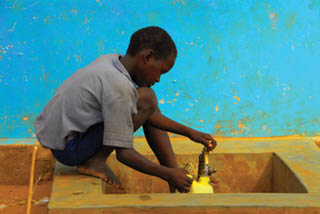Waterborne diseases are responsible for 20 percent of deaths in children under the age of five. Microbes such as E. coli found in fecal matter cause diarrhea that kills by dehydrating its victims. Such organisms are routinely found in the springs, wells, lakes, and rivers used as water sources in the developing world. Naturally-occurring springs, often the most important source of water in these locales, can be cheaply protected by encasing them in concrete. Rather than seeping through the ground, the water flows through a pipe, thus protecting it from microbial contamination. Recent research by Michael Kremer et al. (2011) shows the dramatic impact spring protection can have on waterborne childhood disease and also illuminates why the private sector has not provided such protection.
Naturally-occurring springs are an important source of water in much of the developing world, especially Africa. Kremer et al. focus on Kenya, where almost 75 percent of household water comes from such springs. In Kenya, local customs—and laws affirming such customs—prevent the owners of springs from charging users for the water. Such customs reduce the monetary cost of the water for consumers. But the customs also discourage landowners from investing in spring protection that would ensure access to clean water. The result is high childhood mortality due to waterborne disease.
A spring can be protected from microbial contamination at a cost of about US$1,000, with roughly $30 per year in maintenance costs after that. The authors show that such protection reduces the incidence of E. coli by two-thirds and cuts diarrhea in young children by one-quarter. Despite these clear benefits, it seems unlikely that private action will yield much spring protection in the foreseeable future.
A pivotal reason is the low value placed on human life in Kenya, a value that Kremer et al. are able to directly estimate. The chief cost of acquiring water in much of Kenya is the time spent walking to and from the nearest water sources. Households reveal their preferences for cleaner water when they choose to travel farther to collect water from safer springs. This enables the authors to infer the value households place on clean water and, implicitly, the value they place on the illness and fatalities thereby averted.
The authors estimate that the value to the typical Kenyan household of averting a single case of childhood diarrhea is less than $1, and the value to a household of preventing the death of a young child is less than $800. Overall, Kremer et al. estimate that the typical household would be willing to pay no more than $3 per year for access to a protected spring. These numbers seem stunningly low by western standards, but they reflect the reality of life in much of the developing world. In Kenya, for example, agricultural labor is paid less than $1 a day and per capita national income is only $800 per year.
So what is to be done about deadly water in Kenya or elsewhere in the developing world? Simply mandating that spring owners be permitted to charge for their water would induce some investment in spring protection. But the authors note that there are two problems with this approach. First, Kenyan households place such a low value on the cleanliness of water that private landowners would not be willing to invest much in protection. Indeed, Kremer et al. estimate that, under market pricing, the incidence of privately-protected springs would be only about 5 percent. Second, because the springs are geographically dispersed, each is much like a local monopoly—and subject to monopoly pricing. Such pricing would induce households to switch to other sources such as ponds and rivers that involve more travel time and often are more hazardous than even unprotected springs. Overall, the authors argue, market pricing would actually make most households worse off, which may help explain why the custom of unpriced water originally evolved in Kenya.
The solution to dirty water in Kenya and elsewhere is likely to come only from economic growth, driven by secure property rights and the rule of law. Robert Hall and Chad Jones (2007) have estimated that the demand for health rises roughly with the square of income. This suggests, for example, that a doubling of per capita income would quadruple the demand for spring protection. The spread of legal institutions that facilitate growth will thus eventually raise the willingness to pay for cleaner water above the costs of supplying it. Once that happens, the market will not be far behind in providing what people want—safer water and healthier children.
REFERENCES
Hall, Robert, and Chad I. Jones. 2007. “The Value of Life and the Rise in Health Spending.” Quarterly Journal of Economics 122 (1): 39–72.
Kremer, Michael, Jessica Leino, Edward Miguel, and Alix Peterson Zwane. 2011 “Spring Cleaning: Rural Water Impacts, Valuation, and Property Rights Institutions.” Quarterly Journal of Economics 126 (1): 145–205.




